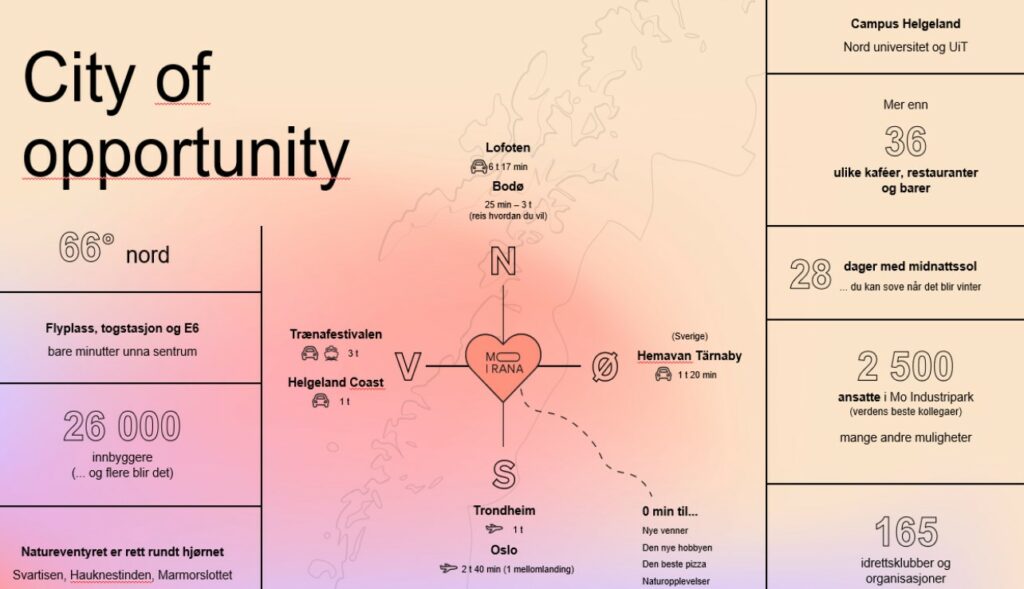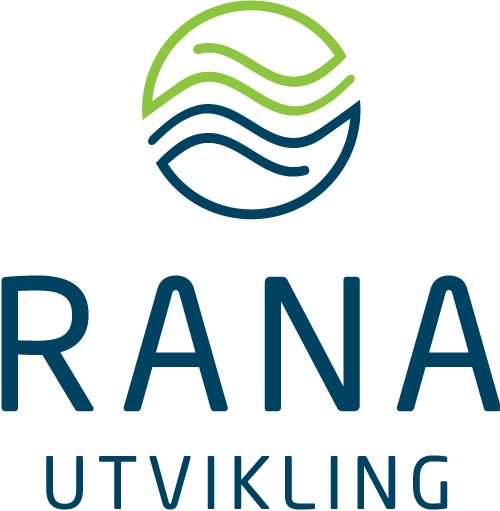About Rana Utvikling
Rana Utvikling’s ambition is to be the region’s leading resource for business growth. Its most important job is to facilitate new commercial activities and improve operating parameters for the business community.
The agency offer free consultations through its business start-up service. It also provides support and services which contribute to growth and development for companies in the region.
As a non-profit agency, all Rana Utvikling’s income is devoted to development work.
The business development plan for Rana local authority, adopted by council’s executive board in June 2019, is Rana Utvikling’s most important strategy document.
Green industrial hub
“Norway’s green industrial capital – the future is renewable”. That is Rana local authority’s vision.
Mo i Rana has one of the country’s most advanced industrial infrastructures, large and robust energy systems, good logistics solutions and access to the most important input factors for green industry.
Mo Industrial Park has a major presence in energy and materials recycling, hosts two data centres and plans to be a hydrogen hub. Its strategic ambition is to be at the forefront of green industry and the circular economy.
Where we are

Mo i Rana is the third largest city in northern Norway with over 26 000 inhabitants. The town is the communications hub for northern Helgeland, with the railway, European highways running north-south and east-west, an airport and one of Norway’s largest seaports.
Solid municipal finances
Healthy municipal finances is described by the ability to handle unforseen incidents and have the resources to make decisions in both the short and long term. A long term governing management focus is important to be able to deliver dependable services. Rana municipality has since the 2016 budget implemented economic rules of action based on a municipalityeconomic sustainability.
The municipalitys economic status can in short be described as such;
The freedom of action has improved since the Terra-affair in 2007. The municcipality has a positive gross degree of performance. This is due to positive results in service production combined with increased tax revenue.
It is important with a stable degree of performance over time that can over time contribute to capital for investments, increased liquidation and be a economic buffer in facing potential challanges. The Norwegian Technical Calculation Commitee (TBU) reccomends a net operating profit at 1,75%. Rana municipality has in its financial plan a target of 3%, motivated by the economic risks regarding the restructure issues facing the municipality. In term of Norwegian Crowns (kr) a net operating profit of 3% is aprox. 64,5 million kr (7,5 million USD). The municipality has over a 10 year period delivered a profit in accordance to the target of 3%, even when Terrapayments are held outside the operating profit.
Rana municipality has heavily invested the last four years, at average 331,8 million kr (38,5 million USD) per year.
Since 2009 the nominal loan debt in Rana municipality has increased by 1222,7 million kr (146,5 million USD). Net loan debt constituted 71,9% of gross operating revenues in 2018. The municipality’s economic sustainability model has maximum for net loan debt at 75% of gross operating revenues. The municipality should not increase its loan debt significantly. The municipality is vunerable to changes in the interest rate level, especially in a situation with less liquidity after investing in the new large airport. Net loan debt in 2018 58723 kr per citizen vs 55723 in 2017. In 2009 the net loan debt was 32116 kr per citizen. For reference the net loan debt per citizen in municipality group 13 was in 2018 72214 kr.
Rana municipality has a relativly moderate gross interest and deduction burden, below the average in the municipality group 13.
Short term and long term liquidity is better than reccomended.
All in all there has been a substansial larger fund since 2009. The total fund capital in Rana is considered good compared to other municipalitites.
Norway's best at restructuring
Did you know that up until 1800 the Rana region was just as sami as Karasjok and Kautokeino is today, and that it has over the last two hundred years gone through a number of large changes? Conversions has become a part of the populations culture and lifestyle. Just as the reindeer husbandry as adapted to nature’s ebbs and flows, the population goes forth in rough weather, and time after time the population has adapted new times and trends.
The first adaption
In Rana boatbuilding has been conducted for centuries, and a ‘ranværing’ (a type of boat buildt in Rana), has since ancient times been a recognized boat among the costal population all the way north to Russia. Sales and distribution was done by local merchants, and when the merchant L.A. Meyer, of german hertiage, established himself in Mo i Rana in 1854 the small village quickly became a leading location for boatproduction that yearly produced 2500 boats of different variants. Meyer bought and rigged the boats for resale and won prizes on international fairs for the brand “Meyers Baadbryggeri”. The production was usually done where people lived, and was then transported by horse in late winter down to Mo. L.A. Meyer became one of the largest and successfull companies in the north, and that also established large scale international trade between the north-swede Lappmarken, Northern Norway and the rest of the world. Abundant deposits of ore and minerals made Mo i Rana famous fra the 1600s. While the average northerner had to travel far, and could face dangers in rough seas and bad weather, the population of Rana had riches beneath their feet. The populations greatest challanges has therefore been of a technological sense, and this has contributed to forming their mentality. Large and small scale mining was put into operation. This made the people used to industry and new technology. It was by no coincidence that the first light bulp shone by the mines on Båsmoen in 1895. This wonder fascinated the population, and in 1907 the first hydropower station on Helgeland was put into operation at Revelfossen.
The second adaption
When Dunderland Iron Ore Company (DIOC) was founded in London 1902, it was positioned as the UKs largest importer of iron ore. British steel mills and the south african mining company De Beers was among the owners. Thomas Alva Edison developed the groundbreaking techonolgical solutions, and the worlds most famous technologist and inventor was personally engaged in the projects that were done in american interest. Two thousand men were put to work to establish mines, large factories, shipping port and a 25 km railway. Mo i Rana was a like a small America, and new techonolgy from abroad quickly made its way to the emerging mining town. The motorization of the northern fishing fleet had hardly begun, but Mo i Rana had established hydropower, railway and industrial labour force. You could travel by train from Mo i Rana to Storforshei before the Bergen railway was finished. Edisons electrical techonolgy was not perfected yet and not useful for the ore in the Dunderland valley. German techonology was put into operation and german steel mills became the new customers, but after three short operational periods the operations were stopped by the outbreak of the second world war in 1939.
The third adaption
The armament to the first and second world wars made it difficult for the young norwegian nation. Norway had no modern iron- or steelproduction, and the high import prices was destructive for norwegian industrialization and shipping, housing and welfare services. In 1936 parliament appointed yet again a dedicated ironcommitee. Late autumn 1939 its reccomendation was clear. and the commitee reffered to what new techonolgy for iron ore production made possible. Parliament was reccomended to greatly expand the creation of hydropower plants and the establishment of a state owned ironworks plant. The commitee highlighted the ore in the Dunderland valley and saw the great potential for hydropower. Few months later the country was occupied, and parliament fled the country. In 1946 a newly elected parliament were not slow to follow up an important point in the parties joint platform after the war: “The iron situation must be solved.” Just as London had done in 1902, parliament chose Mo i Rana. Norwegian Ironworks was buildt from the ground up to become one of the countries largest businesses med an iron ore mine, coking plant, an ore based iron, steel and rolling plant. At the same time large hydropower resources was tamed and repurposed into renewable energy for the ironworks and the community as a whole. People moved from near and far. In the spand of 15 years the population doubled not once, but twice, to ca. 26 000 around 1970. And just as aggressive as last time, new technology was put into action. Out-of-work fishermen, boatbuilders, craftsmen, reindeer shepherds and construction workers from Nordlandsbanen railway was in a few years retrained to operate power stations, melt iron and roll reinforced steel. Norwegian Ironworks became one of the symbols of reconstruction, modernization and national pride after the war. In the 1970s and 80s Norwegian Ironworks was hit hard by the international steel crisis and large changes to the world economy.
The fourth adaption
In the period between 1988 and 1993 a new great adaption came when parliament decided to terminate the ore based steel production in Mo i Rana and at the same time created a package to replace the several thousand lost jobs with new businesses. The population took again the oppertunity. Norwegian Ironworks was repurposed into an industrial park with, over time, 110 businesses and 2500 jobs. The steel industry was privatized, and the businesses developed through using the industrial parks many symbiosises and advantages. Here the sircular economy became a reality long before the term was even invented. There was also created large national institutions based on digitalization, like the National Library, Labour and welfare agency and the State Collection Centre. A more varied business and labour marked not only increased the female participation in the work force, but created a larger demand for higher education. Campus Helgeland was created with higher education and an evergrowing research and development department. To improve accsessability to the rest of the world the infrastructure is being improved by getting a new, large airport and a deep sea quay in Mo i Rana.
The green adaption
150 years after L.A. Meyer put Mo i Rana on the map, 75 years after the creation of Norwegian Ironworks and 30 years after the restructure Mo i Rana is again chosen by national and international actors as a location for establishing their plans. Now we become the hosts for green industry in a large scale. Our region is blessed by great renewable resources, and a highly skilled labour force and infrastructure. But the power of progress is still based evenly between the businesses and the people who an openess to the world, that take technological oppertunities and adapt to new times and trends. The people of Mo i Rana still has adaption in their blood.
